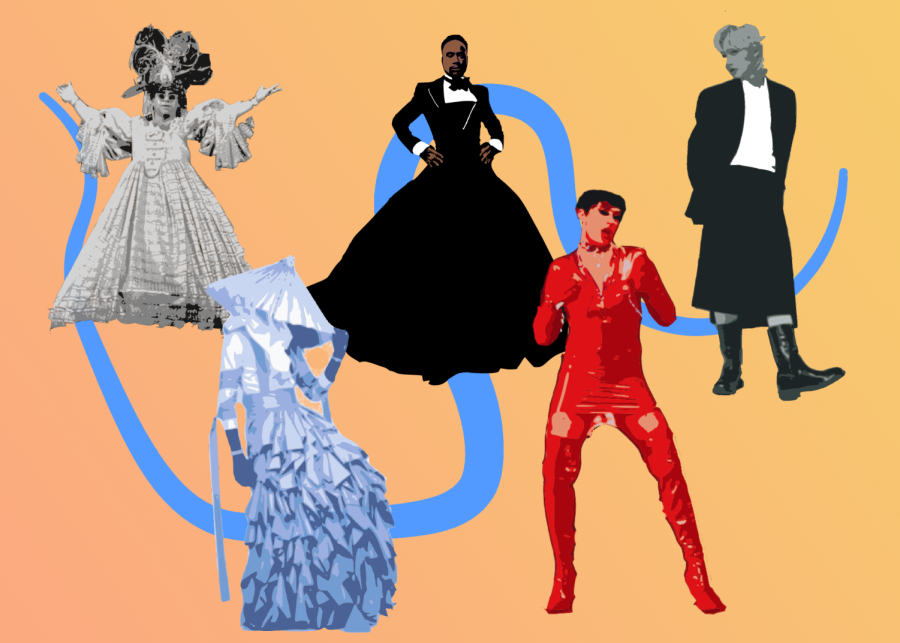Harry Styles isn’t the epitome of androgynous fashion
Graphic illustration by Timothy Kim
Elton John, Young Thug, Billy Porter, Bad Bunny, and Stray Kids are just a few of the prominent trailblazers of androgynous fashion.
May 3, 2022
Fashion has long been a form of self-expression, but as androgynous or gender non-conforming fashion begins to enter the mainstream, public figures have often received polarizing media attention for their outfits.
However, Harry Styles is often the artist who receives credit for his work to break boundaries. Not to say that Styles doesn’t have a unique sense of style or that he hasn’t challenged gender norms in his own way, but his recognition steals the spotlight from many other celebrities, namely people of color, who have done just as much — if not more — to defy gender norms with their fashion. Even more so, Style’s outfits tend to be specifically curated to gain attention instead of stemming from his personal fashion sense.
The media’s fixation on Styles can be seen through the uproar his simple, sheer Gucci shirt received at the 2019 Met Gala — a small touch that received more media coverage than the outfits of all the other celebrities combined. In recent years, Styles has been on the cover of several Vogue issues in feminine styles or silhouettes. Despite the general Twitter uproar regarding his outfits, there was greater support for his revolutionary style than bemoaning for the loss of traditional masculinity.
Yet all of these outfits were specifically curated for media attention. Several were heavily influenced by icons before him such as Prince and Bowie and reflect none of Styles’s personal style.
“Trends like white boy of the month and craze for Harry Styles overrepresent white men in media,” senior and Indesign President Suanna Zhong said. “So many people overlook other artists who did it first, such as Prince or Billy Porter. However, with artists like Lil Nas X using their platform to be unapologetic and taking bold moves to defy gender norms, we will slowly move in the right direction.”
Other artists who don’t receive due attention for their work to break gender norms have wardrobe choices that are more reflective of their own personality. Furthermore, these figures were breaking gender roles before Styles entered the scene. Of the most iconic are Sir Elton John’s diverse and astonishing outfits, such as his 1975 Dodger stadium performance outfit studded with sequins or his 1997 birthday suit inspired by King Louis XIV. Closer to home is Prince, a musician remembered through generations for his androgynous style and flamboyant character. Further down the line, more expressive personal styles became popular in Western culture, from Young Thug’s dress on the No, My Name is JEFFREY mixtape cover to Lil Nas X’s outfit at the 2020 Grammys. All of these outfits did more than Harry Styles’s poorly curated editorial by actually redefining what masculine fashion could be.
This stronger sense of personal style and nonconformity of gender norms is mainly expressed through both the spontaneity and purpose of the outfits. These outfits were not meant to be the statement of the occasion or had a particular point to get across; instead, they seemed to stem from preference and comfort. The lack of public attention for said outfits contrasts sharply to that for Styles’s calculated wardrobe choices, with some earlier trendsetters even receiving derision for their choices.
This rundown of celebrity fashion’s role in redefining masculinity would be incomplete without looking at the greater influence K-Pop has had on universal fashion standards and redefinition of gender norms. Arguably one of the most alluring aspects of the K-Pop industry is its idols’ elaborate self expression, namely in dress and attire. This aspect is reflected in both male and female idols’ remarkable costumes and makeup. Despite mainstream rejection at their expression, it is these facets of K–Pop that not only grow its international fanbase but also redefine masculinity on a global scale.
From EXO member Kai’s crop tops in music videos to Stray Kid member Felix’s skirt photoshoots, all of the choices show a fluidity and disregard of gender stereotypes that many artists from other cultures are hesitant to express. Outfits like these are still not as common in Western media, as they tend to relate to the stereotype that one’s fashion sense is a result of their sexual orientation, which strengthens the presence of toxic masculinity.
“When people who don’t know or aren’t familiar with K-Pop see it, they can jump to a lot of conclusions about the artist,” junior and LHS Ravens member Maia Bline said. “But in the past few years, people have been more open to a less strictly masculine style and have a more inclusive perception of others and their styles thanks to K-Pop.”
Evidently, the difference in media treatment towards Harry Styles and other artists that have expressed androgynous fashion shows a repetitive and sickening double standard of some receiving praise for the same thing others get ridiculed for. Only when celebrities of color garner the same recognition of their work in combating gender norms can the male fashion industry move forward in a meaningful way.




































































